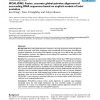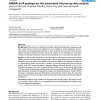20878 search results - page 4085 / 4176 » Database |
BMCBI
2006
14 years 10 months ago
2006
Sequence homologs are an important source of information about proteins. Amino acid profiles, representing the position-specific mutation probabilities found in profiles, are a ri...
BMCBI
2006
14 years 10 months ago
2006
Background: Massive gene expression changes in different cellular states measured by microarrays, in fact, reflect just an "echo" of real molecular processes in the cell...
BMCBI
2006
14 years 10 months ago
2006
Background: Proteins that are similar in sequence or structure may perform different functions in nature. In such cases, function cannot be inferred from sequence or structural si...
BMCBI
2006
14 years 10 months ago
2006
Background: Non-coding DNA sequences comprise a very large proportion of the total genomic content of mammals, most other vertebrates, many invertebrates, and most plants. Unravel...
121
click to vote
BMCBI
2006
14 years 10 months ago
2006
Background: Microarrays are routinely used to assess mRNA transcript levels on a genome-wide scale. Large amount of microarray datasets are now available in several databases, and...


